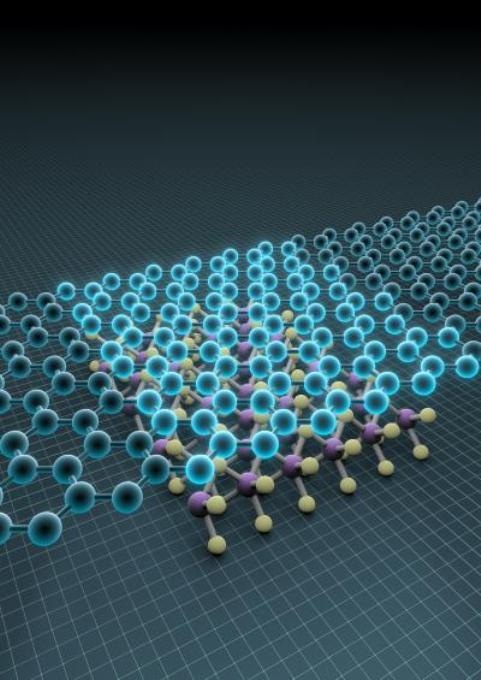Dec 12 2017
A group of researchers from the Graphene Flagship has predicted and demonstrated a giant spin anisotropy in graphene – the single-atom-thick allotrope of carbon – and associated materials (GRMs) such as transition metal dichalcogenides (TMDCs). This latest development paves the way for new spintronic logic devices.
 Schematic image showing graphene-TMD heterostructure. The TMD causes giant anisotropy in spin transport in graphene. (Credit: Dámaso Torres, ICN2)
Schematic image showing graphene-TMD heterostructure. The TMD causes giant anisotropy in spin transport in graphene. (Credit: Dámaso Torres, ICN2)
The powerful collaborative ethos of the Graphene Flagship is speeding up developments in novel technologies based on graphene. The unique tuneable electronic properties of graphene make it a perfect material for spintronics applications. Spearheading the way in three recent papers, the Flagship research team has demonstrated that GRMs can be integrated to create an unparalleled spin lifetime anisotropy, which is important for expediting spintronics. Spintronics are electronic devices and circuits based on the manipulation of electron spins. The three papers were published almost at the same time in Physical Review Letters, Nature Physics, and Nano Letters.
"These results represent a first step to achieving direct electric-field tuning of the propagation of spins in graphene," said ICREA Prof. Sergio O. Valenzuela, an author of the experimental results in Nature Physics and a researcher at the Catalan Institute of Nanoscience and Nanotechnology (ICN2; Spain), and. "A graphene-TMDC structure responds as a spin filter with a transmission determined by the orientation of the spins that reach it, allowing detection of small orientation changes."
The close collaboration between the research groups, working at Graphene Flagship partner institutes ICN2, the University of Regensburg (Germany), and the University of Groningen (the Netherlands) enabled the prediction and quick verification of this spin-lifetime anisotropy regime that was not known before. Working as part of Graphene Flagship's dedicated Spintronics work package, the research teams determine common goals and maintain close relationships, gaining from the Flagship's exceptional approach to collaborative and interdisciplinary research.
This is a nice example of how the Flagship makes it possible to make progress by a combination of challenging science and technology, collaborations, and a fruitful interaction between theory and experiment. After our 'proof of principle' the next challenge will be to demonstrate and apply our findings in spintronic devices based on large scale graphene and related materials.
Prof. Bart van Wees, University of Groningen, Leader of the Spintronics Work Package
"The Flagship's Spintronics Work Package demonstrates excellence in covering the innovation value chain in spintronic, from novel theoretical concept to fast experimental prototypes, on the way towards disruptive spin device technologies," added ICREA Prof. Stephan Roche (ICN2), deputy of the Spintronics Work Package and co-author of the article that predicted the phenomenon of spin anisotropy. "I think this is the first time that a ground-breaking theoretical prediction is confirmed experimentally so shortly after its publication. In a sense it reflects the acceleration process allowed by the Flagship concept."
In addition, spintronics is especially interesting for new types of fast and efficient memory storage and quantum computing. Similar to electronics, spintronics depends on the production and manipulation of currents but in the case of spintronics, the transport of the electrons' spins forms the currents. These electrons' spins are the intrinsic electron angular momentum with no equivalent in traditional physics. In the case of graphene devices, an electron's spin can be effortlessly injected either perpendicular or parallel to the plan of the graphene layer.
The latest research demonstrates that spin transport in graphene can be considerably affected by proximity effects in heterostructures of TMDCs and graphene, such as tungsten disulphide and molybdenum disulphide. The behaviors of the perpendicular and parallel spin orientations in graphene are significantly changed through inter-layer coupling. This results in an anisotropic spin relaxation from one to several orders of magnitude.
Spin relaxation is the mechanism through which an electron's spin becomes random by losing its initial polarization. This results in the disappearance of spin information signal. This study makes it possible to control the lifetime of various spin orientations in graphene – a major element required for spintronic logic devices and applications.
Besides being a significant step forward towards the possible application of graphene and related materials in spintronics, these papers show the added value of the collaborative environment established by the Graphene Flagship. They also constitute a bridge towards the newly announced Quantum Flagship.
Prof. Andrea C. Ferrari, Science and Technology Officer of the Graphene Flagship, and Chair of its Management Panel